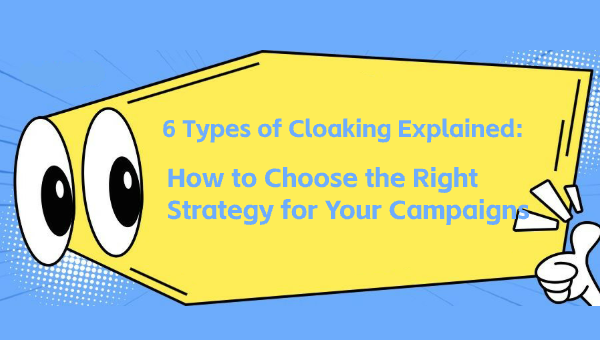6 Types of Cloaking Explained: How to Choose the Right Strategy for Your Campaigns
Cloaking is no longer a buzzword in performance marketing—it’s a foundational part of how many aggressive advertisers operate under platform scrutiny.
But not all cloaking methods are created equal. Below, we break down the 6 core types of cloaking and when to use each.

1. IP Cloaking
How it works:
Detects visitor IP and compares it to known lists (e.g., ad reviewers, bots, or bad traffic sources).
Best for: Blocking Google, Facebook, TikTok reviewers.
2. User-Agent (UA) Cloaking
How it works:
Filters visitors based on browser or device identifiers.
Best for: Filtering bots or headless browsers pretending to be users.
3. Referer Cloaking
How it works:
Looks at the referral URL or domain to determine if the visit came from a risky source.
Best for: Avoiding test traffic or flagged referrers.
4. JavaScript Cloaking
How it works:
Delivers core content only if the browser supports and executes JS correctly.
Best for: Filtering non-browser bots or systems without JS support.
5. Cookie Cloaking
How it works:
Tracks session behavior or cookie patterns to identify repeat visits, bots, or reviewers.
Best for: Controlling who sees content based on visit patterns.
6. Time-based Cloaking
How it works:
Triggers content visibility based on access time, useful to avoid platform patrol hours.
Best for: Scheduled content switching or stealth rollouts.
Which Strategy is Right for You?
| Platform | Recommended Combo |
|---|---|
| Google Ads | IP + UA + Referer |
| IP + Cookie | |
| TikTok | IP + Time-based |
| Push/Natives | UA + JS |
Final Thoughts
The best cloaking systems don’t rely on just one method. They combine several types of cloaking for robust filtering, better security, and long-term survival.
At AdCloaking, we offer:
Drag & drop rule builder
IP + UA + JS multi-layer filtering
Real-time logs
Prebuilt templates for 10+ platforms
Start cloaking smart: https://adcloaking.com
